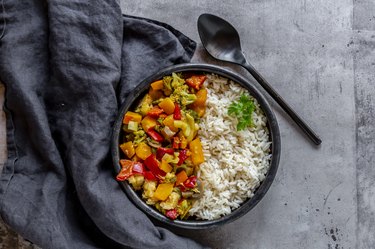
Sodium, most commonly in the form of table salt, is essential to the natural electrolyte balance that protects your body from dehydration and serves other crucial functions. Sodium intake is a delicate balance, as excess consumption can increase your blood pressure and potentially cause kidney damage.
Tip
All varieties of rice contain little or no sodium — between 0 and 5 milligrams of sodium per cup — when prepared without added table salt.
Video of the Day
White Rice
Cooked white rice is sodium-free when cooked in water with no added salt. Any addition of salted butter, broth or salt-blended seasonings will add sodium. White rice in its original form contains no sodium.
Video of the Day
Brown Rice
Brown rice is the result of a refining process that removes only the first layer, or husk, of the rice grain. Cooked in water without added salt, brown rice contains 2 milligrams of sodium per cup.
You should eat less than 2,300 milligrams of sodium daily, according to the Dietary Guidelines for Americans, and only 1,500 milligrams or less if your doctor recommends a low-sodium diet to address diabetes, high blood pressure or other risk factors.
Brown rice contains more sodium than white rice, but it's still a trivial amount, and it also provides 3 additional grams of fiber and fewer overall carbohydrates.
Related Reading
Wild Rice
Wild rice contains 5 milligrams of sodium per cup, only slightly more than white and brown rice. Wild rice provides fewer carbohydrates than white or brown varieties, and offers 3 grams of dietary fiber per serving. Wild rice also offers 6 grams of protein per cup, 2 grams more than a similar serving of brown and white rice.
Tip
Sodium content in the rice is minimal, but when you purchase prepackaged rice dishes and sides with the seasonings included, the seasonings are often very high in sodium. Regulate the sodium in prepared side dishes by making the rice and seasoning it yourself with herbs and spices to suit your flavor preferences and limiting added sodium.
Was this article helpful?
150 Characters Max
0/150
Thank you for sharing!
Thank you for your feedback!